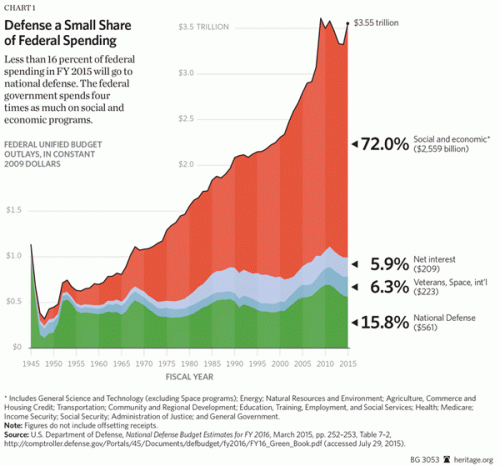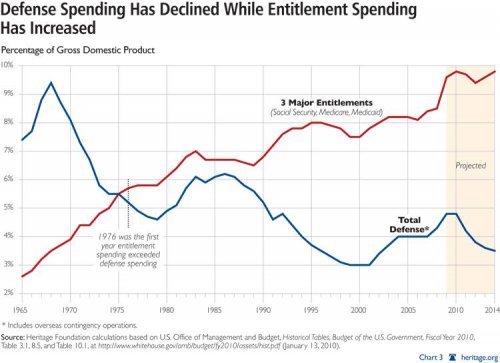You are using an out of date browser. It may not display this or other websites correctly.
You should upgrade or use an alternative browser.
You should upgrade or use an alternative browser.
Global Military Spending - NEWS ONLY
- Thread starter bobbymike
- Start date
-
- Tags
- 21st century
- Joined
- 21 April 2009
- Messages
- 13,161
- Reaction score
- 6,029
http://www.realcleardefense.com/articles/2016/07/06/us_factory_orders_fall_as_military_spending_plunges_109527.html
Orders for military aircraft, a volatile category, plummeted 35.3 percent in May. The decline was compounded by drops in demand for military communications and navigation equipment.
- Joined
- 21 April 2009
- Messages
- 13,161
- Reaction score
- 6,029
- Joined
- 21 April 2009
- Messages
- 13,161
- Reaction score
- 6,029
Finding Budget Stability
—Will Skowronski
8/30/2016
The use of overseas contingency operations funds to meet non-war needs hinders effective planning and budgetary discipline, former Pentagon comptroller Robert Hale said Monday. As OCO funding is not subject to binding budget caps, it has been increasingly used to fund non-war needs, said Hale, now a Booz Allen Hamilton fellow, during a panel discussion hosted by the Brookings Institution in Washington, D.C., while introducing a paper on the same topic. But unlike base budget requests, OCO requests do not include a multi-year plan that guide the funding. “DoD tries to do long-term planning to have a consistent five-year plan so you don’t buy a bunch of stuff you can’t support in the out years,” Hale said. “OCO is a one-year budget, that’s the best you can do. It’s hard enough to plan war-time needs one year in advance. If you start putting large amounts of the base budget in OCO, you lose all of that consistent planning.” The lack of competition with other funding initiatives within OCO also erodes budgetary discipline, Hale said.
Transitioning non-war costs—which could amount to between $20 to $30 billion a year depending on how wartime operations is defined—back to the base budget would be the ideal solution to protect the use of OCO funds to meet the needs of warfighters, but it is not practical in the current political environment, Hale argued. Instead, according to Hale’s paper, the next administration should avoid funding any new, non-war activities with OCO funds and, where feasible, move some non-war initiatives, including the Counterterrorism Partnerships Fund and European Reassurance Initiative, back to the base budget. But Hale said finding a predictable and reasonable level of funding for federal agencies will be the most important financial issue the next administration will face, and that effort will require much larger compromises. “And the only way to do that, in my view, is a long-term, broad budget deal, one that gets us beyond looking at just defense and non-defense, but includes mandatory spending—social security, Medicare—and revenues, and considers all of those in the context of the deficit,” Hale said. Hale said he is hopeful, but not quite optimistic, that a new administration will be able to broker such a deal. (See also: Report: OCO Uncertainty is Dangerous.)
—Will Skowronski
8/30/2016
The use of overseas contingency operations funds to meet non-war needs hinders effective planning and budgetary discipline, former Pentagon comptroller Robert Hale said Monday. As OCO funding is not subject to binding budget caps, it has been increasingly used to fund non-war needs, said Hale, now a Booz Allen Hamilton fellow, during a panel discussion hosted by the Brookings Institution in Washington, D.C., while introducing a paper on the same topic. But unlike base budget requests, OCO requests do not include a multi-year plan that guide the funding. “DoD tries to do long-term planning to have a consistent five-year plan so you don’t buy a bunch of stuff you can’t support in the out years,” Hale said. “OCO is a one-year budget, that’s the best you can do. It’s hard enough to plan war-time needs one year in advance. If you start putting large amounts of the base budget in OCO, you lose all of that consistent planning.” The lack of competition with other funding initiatives within OCO also erodes budgetary discipline, Hale said.
Transitioning non-war costs—which could amount to between $20 to $30 billion a year depending on how wartime operations is defined—back to the base budget would be the ideal solution to protect the use of OCO funds to meet the needs of warfighters, but it is not practical in the current political environment, Hale argued. Instead, according to Hale’s paper, the next administration should avoid funding any new, non-war activities with OCO funds and, where feasible, move some non-war initiatives, including the Counterterrorism Partnerships Fund and European Reassurance Initiative, back to the base budget. But Hale said finding a predictable and reasonable level of funding for federal agencies will be the most important financial issue the next administration will face, and that effort will require much larger compromises. “And the only way to do that, in my view, is a long-term, broad budget deal, one that gets us beyond looking at just defense and non-defense, but includes mandatory spending—social security, Medicare—and revenues, and considers all of those in the context of the deficit,” Hale said. Hale said he is hopeful, but not quite optimistic, that a new administration will be able to broker such a deal. (See also: Report: OCO Uncertainty is Dangerous.)
- Joined
- 21 April 2009
- Messages
- 13,161
- Reaction score
- 6,029
Senate Defense Budget Would Shift R&D Burden to Industry
— Wilson Brissett
8/31/2016
A less-discussed feature of the Senate defense authorization bill would shift the burden of research and development costs from the government to industry, a defense budget expert said Tuesday. Andrew Hunter, a senior fellow at the Center for Strategic and International Studies said the Senate’s change in military contracting rules includes a 1 percent penalty con cost-plus contracts. There was a time when “the DOD drove research and development elsewhere in the US and worldwide. But today that is not even close to being true,” Hunter said during a budget discussion at The Heritage Foundation in Washington, D.C. The penalty, Hunter said, would incentivize fixed-cost contracts in which a military contractor takes on the risks related to research and development of new technologies. This shift signals a “new era where new technologies will not be developed on the government dime,” he said.
— Wilson Brissett
8/31/2016
A less-discussed feature of the Senate defense authorization bill would shift the burden of research and development costs from the government to industry, a defense budget expert said Tuesday. Andrew Hunter, a senior fellow at the Center for Strategic and International Studies said the Senate’s change in military contracting rules includes a 1 percent penalty con cost-plus contracts. There was a time when “the DOD drove research and development elsewhere in the US and worldwide. But today that is not even close to being true,” Hunter said during a budget discussion at The Heritage Foundation in Washington, D.C. The penalty, Hunter said, would incentivize fixed-cost contracts in which a military contractor takes on the risks related to research and development of new technologies. This shift signals a “new era where new technologies will not be developed on the government dime,” he said.
- Joined
- 9 October 2009
- Messages
- 19,908
- Reaction score
- 10,417
http://thehill.com/policy/defense/293712-speakers-office-portends-presidential-veto-of-defense-bill
- Joined
- 21 April 2009
- Messages
- 13,161
- Reaction score
- 6,029
http://www.stripes.com/news/f-a-18-crashes-rise-rapidly-as-budget-constraints-have-led-to-overused-planes-undertrained-pilots-1.426688?utm_content=bufferfac5a&utm_medium=social&utm_source=facebook.com&utm_campaign=buffer
- Joined
- 21 April 2009
- Messages
- 13,161
- Reaction score
- 6,029
http://aviationweek.com/combat-aircraft/us-air-force-s-big-modernization-plans?NL=AW-18&Issue=AW-18_20160909_AW-18_516&sfvc4enews=42&cl=article_2&utm_rid=CPEN1000000230026&utm_campaign=6968&utm_medium=email&elq2=64c4c4c34d5a47079bdc1c97c9eef1ac
- Joined
- 9 October 2009
- Messages
- 19,908
- Reaction score
- 10,417
http://www.washingtonexaminer.com/fowl-play-sage-grouse-pushes-defense-bill-into-the-lame-duck/article/2602339
http://www.defensenews.com/articles/defense-policy-negotiators-play-chicken-on-sage-grouse-provision
http://www.defensenews.com/articles/defense-policy-negotiators-play-chicken-on-sage-grouse-provision
- Joined
- 9 October 2009
- Messages
- 19,908
- Reaction score
- 10,417
https://warisboring.com/happy-15th-birthday-to-americas-endless-war-in-afghanistan-60fe09c4fcef#.3qdpmcajz
- Joined
- 3 June 2011
- Messages
- 17,331
- Reaction score
- 9,058
bobbymike said:For the cost of an F-35........................
http://www.usatoday.com/story/news/nation-now/2016/09/29/military-could-spend-up-84-million-annually-reassignment-treatments/91218672/
Why should the US military be footing this bill? All these idiots should be getting is a dishonorable discharge and boot to ass for wasting the taxpayer's money training them. (Which they should have to pay back.)
- Joined
- 21 April 2009
- Messages
- 13,161
- Reaction score
- 6,029
http://dailysignal.com/2016/10/19/the-government-just-spent-168-billion-more-than-the-year-before/
Should be the opposite
The government spent more than $1.8 trillion in fiscal 2016 on three entitlement programs on autopilot: Medicare, Medicaid, and Social Security. Outlays for these programs grew by $77 billion since fiscal 2015.
To put this into perspective, military spending totaled $564 billion, or less than one-third of what entitlements swallow.
Should be the opposite
- Joined
- 21 April 2009
- Messages
- 13,161
- Reaction score
- 6,029
http://www.nextbigfuture.com/2016/10/proposed-us-defense-budget-suggests.html?utm_source=feedburner&utm_medium=feed&utm_campaign=Feed%3A+blogspot%2Fadvancednano+%28nextbigfuture%29&utm_content=FaceBook
- Joined
- 21 April 2009
- Messages
- 13,161
- Reaction score
- 6,029
No More Fat to Cut
—Will Skowronski11/2/2016
A long-term continuing resolution could “potentially break programs apart,” Air Mobility Command chief Gen. Carlton Everhart said Tuesday. “I have moved programs and shifted programs across the [Future Years Defense Program] so I can pay the immediate bills, but I will submit to you that any more tweaking of that, and I am cutting into the bone. There’s no more fat, there’s no more muscle; I’m cutting into the bone,” Everhart told the audience at the National Defense Transportation Association fall meeting in St. Louis. “So we’re watching this very closely as it comes up, and we’re working hand in hand with Congress to make sure that the budget stays viable.” Everhart said discussions will continue in a few weeks. In September, Air Force Chief of Staff Gen. David Goldfein warned a long-term continuing resolution would reduce the service’s requested budget by $1.3 billion and, in turn, reduce the number of KC-46s it can procure from 15 to 12 in 2017. It also will affect at least 60 acquisition projects, said Goldfein at the time.
—Will Skowronski11/2/2016
A long-term continuing resolution could “potentially break programs apart,” Air Mobility Command chief Gen. Carlton Everhart said Tuesday. “I have moved programs and shifted programs across the [Future Years Defense Program] so I can pay the immediate bills, but I will submit to you that any more tweaking of that, and I am cutting into the bone. There’s no more fat, there’s no more muscle; I’m cutting into the bone,” Everhart told the audience at the National Defense Transportation Association fall meeting in St. Louis. “So we’re watching this very closely as it comes up, and we’re working hand in hand with Congress to make sure that the budget stays viable.” Everhart said discussions will continue in a few weeks. In September, Air Force Chief of Staff Gen. David Goldfein warned a long-term continuing resolution would reduce the service’s requested budget by $1.3 billion and, in turn, reduce the number of KC-46s it can procure from 15 to 12 in 2017. It also will affect at least 60 acquisition projects, said Goldfein at the time.
- Joined
- 9 October 2009
- Messages
- 19,908
- Reaction score
- 10,417
http://cdrsalamander.blogspot.ie/2016/11/a-path-to-350-heres-one-right-in-front.html
- Joined
- 21 April 2009
- Messages
- 13,161
- Reaction score
- 6,029
http://www.nextbigfuture.com/2016/11/china-india-and-megacities-2030-2050.html?utm_source=feedburner&utm_medium=feed&utm_campaign=Feed%3A+blogspot%2Fadvancednano+%28nextbigfuture%29&utm_content=FaceBook


